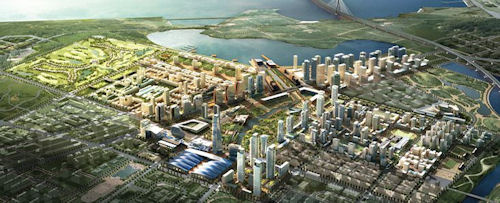Songdo, a city 40 miles from Seoul, South Korean, can easily generate a case of “thinking big” envy. The Songdo International Business District, being built from scratch, aspires to become “the world’s smartest, greenest city” and “the commercial epicenter” of Northeast Asia. It’s a 1,500-acre mixed-use project with 600 acres of open space and parks, an advanced technology infrastructure, signature buildings designed by world-class star-chitects, and a commitment to sustainable design.
Among other highlights, Sangdo’s development consortium is partnering with Cisco Systems to impregnate the business district with smart-city services such as integrated building and facility management, on-premises safety and security, home networking and virtual concierge services. Businesses will have access to state-of-the-art video conferencing technology. Residents will be able to control lighting, HVAC, gas, curtains and other home devices with touch-screen wall pads, computers, tablets and smart phones.
Can anyone imagine such a project taking place in Virginia? Not by a long shot. Twenty years ago, Korea was still considered an “emerging” economy. Now it’s pole vaulting past us. It won’t be long before the Koreans and other East Asians consider us the developing economy.
But before you anyone spazzes out with wild-eyed ideas of sinking tens of billions of dollars Virginia doesn’t have into keeping up with the Jeungs, heed the words of Carlo Ratti and Anthony Townsend in a an article, “The Social Nexus,” in Scientific American.
Real estate developers, global information-technology companies and governments are attempting to build urban centers from scratch that are filled with technologically enhanced infrastructure and services. The designers say their grand conceptions will determine how future cities will be built.
But as models, these top-down projects pale in comparison to the emergent form of intelligence that is bubbling up from millions of newly cyber-connected residents. Truly smart — and real — cities are not like an army regiment marching in lockstep to the commander’s orders; they are more like a shifting flock of birds or school of fish, in which individuals respond to subtle social and behavioral cues from their neighbors about which way to move forward.
Ratti and Townsend advocate a ground-up approach to creating smart cities. The potential for change already exists thanks to the digital technologies already blanketing our cities: broadband fiber-optic and wireless technology grids connected with increasingly affordable PCs, tablets and smartphones, supplemented by a network of sensors and digital control technologies. Thanks to smart phones embedded with a GPS capability, every person becomes a sensor. “Our cities,” they write, “are quickly becoming like ‘cities in the air.'”
Here’s the key: Networked individuals can contribute vast amounts of data that would be useless individually but can provide valuable information in the aggregate.
The Copenhagen Wheel, a hybrid-like mechanism for storing otherwise wasted energy in bicycles, doubles as a sensor that measures temperature, humidity, noise and pollution data — data than can be mapped and made accessible on smart phones.
Trash Track in Seattle embedded electronic tags in household trash to track what happened to more than 2,000 items, including recyclable materials, hazardous waste such as rechargeable batteries, and electronics. One printer cartridge traveled 6,152 kilometers. Some ended up in illegal destinations.
Instead of building a costly network of dedicated vehicle sensors along roadways, Google polls a network of anonymous volunteers whose mobile devices report their location, thus revealing where traffic is flowing, slowed or stopped.
Ratti and Townsend advocate embedded sensors and actuators in buildings, plazas and even sculptures: “We need to build mechanisms for scanning, evaluating and cross-fertilizing good ideas — ways to spread the best methods for crowd-sourcing public services or using citizens as sensors.” In contrast to a top-down vision imposed by master designers, they argue, a bottom-up approach is inherently more innovative, flexible and tailored to the wishes and culture of the people.
Virginia cities don’t need to spend billions of dollars building Songdos from scratch. But we have to get off our derrieres and take the “smart city” concept seriously. By adopting the decentralized, bottom-up approach advocated by Ratti and Townsend, we can accomplish remarkable things to improve the livability of our communities. But someone has to take the lead. Is there anyone out there who might be interested in collaborating with Bacon’s Rebellion in drumming up interest?



